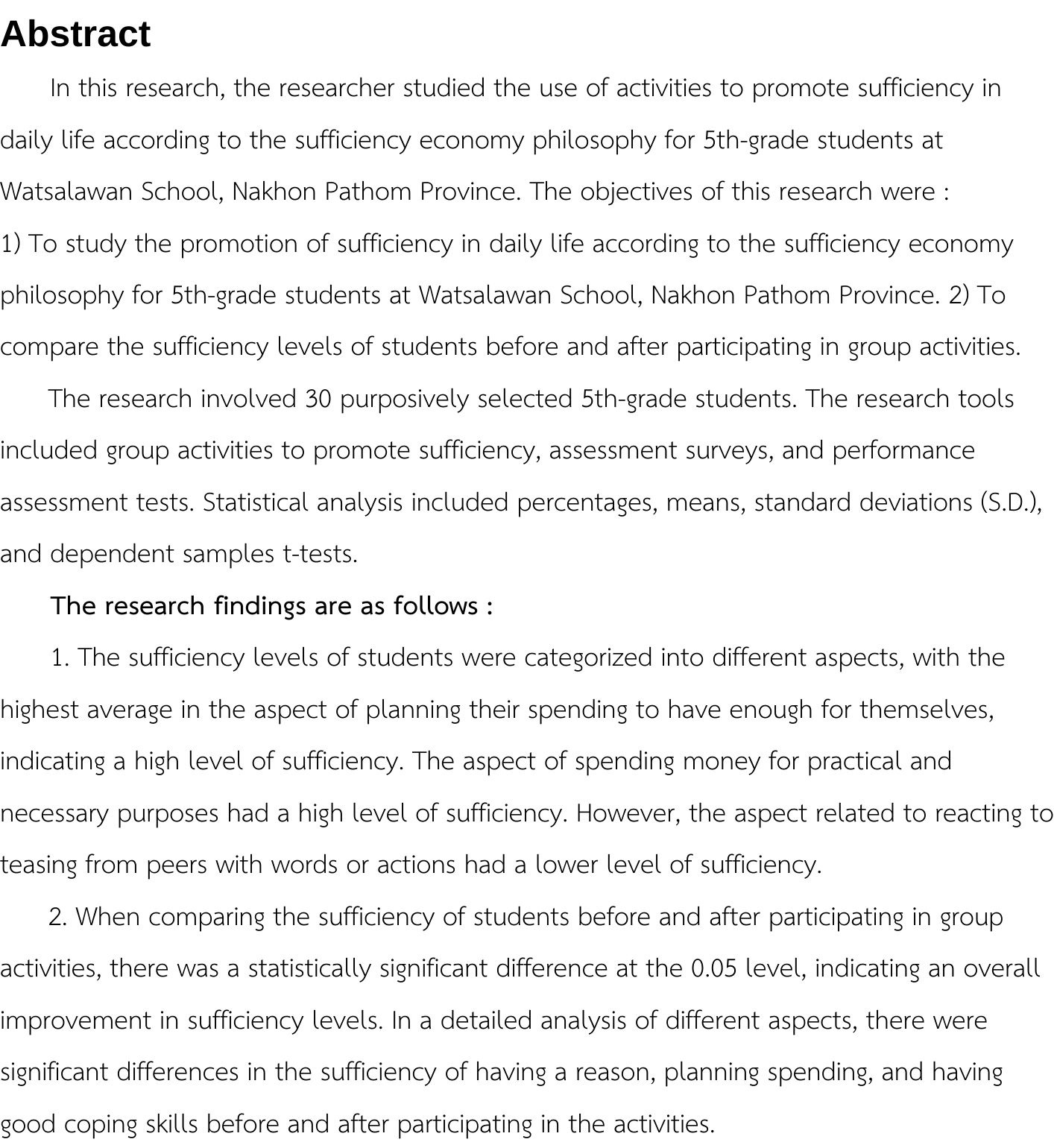Using activities to promote sufficiency in daily life according to the sufficiency economy philosophy for 5th-grade students at Sathalanwan School, Nakhon Pathom Province.
Keywords:
sufficiency-promoting activities, sufficiency level, sufficiency economy philosophyAbstract
In this research, the researcher studied the use of activities to promote sufficiency in daily life according to the sufficiency economy philosophy for 5th-grade students at Watsalawan School, Nakhon Pathom Province. The objectives of this research were: 1) To study the promotion of sufficiency in daily life according to the sufficiency economy philosophy for 5th-grade students at Watsalawan School, Nakhon Pathom Province. 2) To compare the sufficiency levels of students before and after participating in group activities.
The research involved 30 purposively selected 5th-grade students. The research tools included group activities to promote sufficiency, assessment surveys, and performance assessment tests. Statistical analysis included percentages, means, standard deviations (S.D.), and dependent samples t-tests.
The research findings are as follows:
- The sufficiency levels of students were categorized into different aspects, with the highest average in the aspect of planning their spending to have enough for themselves, indicating a high level of sufficiency. The aspect of spending money for practical and necessary purposes had a high level of sufficiency. However, the aspect related to reacting to teasing from peers with words or actions had a lower level of sufficiency.
- When comparing the sufficiency of students before and after participating in group activities, there was a statistically significant difference at the 0.05 level, indicating an overall improvement in sufficiency levels. In a detailed analysis of different aspects, there were significant differences in the sufficiency of having a reason, planning spending, and having good coping skills before and after participating in the activities.
References
คณะกรรมการพัฒนาการเศรษฐกิจและสังคมแห่งชาติ, สำนักงาน. (2549). สรุปผลการพัฒนาประเทศไทยตลอดช่วงแผนพัฒนาเศรษฐกิจแห่งชาติฉบับที่ 1-9 ที่ผ่านมา, มติชน, หน้า 12.
จารุวรรณ ขจรอนันต์.(2562). การประยุกต์ใช้หลักปรัชญาของเศรษฐกิจพอเพียงในชีวิตประจำวันของนักเรียนโรงเรียนสีดาวิทยา อำเภอสีดา จังหวัดนครราชสีมา. ปริญญาครุศาสตร์มหาบัณฑิต สาขาวิชาสังคมศึกษา. มหาวิทยาลัยราชภัฎมหาสารคาม.
ธนาภรณ์ ธิราพืช, วีระ วงศ์สรรค์, และธนาดล สมบูรณ์. (2565). การพัฒนาผลสัมฤทธิ์ทางการเรียน เรื่อง เศรษฐกิจพอเพียงกับการพัฒนาเศรษฐกิจไทย โดยใช้กระบวนการเรียนรู้แบบผสมผสาน สำหรับนักเรียนชั้นมัธยมศึกษาปีที่ 4 โรงเรียนในกลุ่มสหวิทยาเขตพิมานปฐม สังกัดสำนักงานเขตพื้นที่การศึกษามัธยมศึกษานครปฐม. วารสารวิจยวิชาการ, 5(6), 217-232.
วีระ ปันทรัพย์. (2551). การศึกษาสภาพการจัดการเรียนรู้ตามหลักเศรษฐกิจพอเพียงของครูโรงเรียนสังกัดสำนักงานเขตพื้นที่การศึกษาสมุทรสาคร อำเภอเมืองสมุทรสาคร. สารนิพนธ์ กศ.ม.(การบริหารการศึกษา). กรุงเทพฯ : บัณฑิตวิทยาลัย มหาวิทยาลัยศรีนครินทรวิโรฒ. ถ่ายเอกสาร.
อารีย์ เชื้อเมืองพาน. (2550, มีนาคม-เมษายน). เศรษฐกิจพอเพียง : ทางรอดของเศรษฐกิจไทย. วารสารแม่โจ้ปริทัศน์, 8(2), 66.
ล้วน สายยศ. (2556). เทคนิคการวิจัยทางการศึกษา. (พิมพ์ครั้งที่ 5). กรุงเทพฯ : สุวีริยาส์น.

Downloads
Published
How to Cite
Issue
Section
License
Copyright (c) 2024 Institute of Sufficiency Journal

This work is licensed under a Creative Commons Attribution-NonCommercial-NoDerivatives 4.0 International License.



